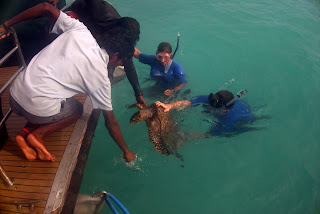Hi there! So after my action packed first week that included learning about El Nino’s effects, relocating slow growing coral, removing crown of thorns star fish and the arrival of the manta rays I didn’t think things could get much better; how wrong I was! Since then I have been lucky enough to have more incredible manta encounters, rescue a female Hawksbill turtle, partake in our world oceans day activities and conduct growth surveys of the coral lines.
| If you look closely there are 7 Mantas in this shot! |
Debs and I accompanied some guests on a dive to Lankan Beyru with the intention of seeing some Mantas at the cleaning station, giving me the opportunity to hone my ID photography skills. Nothing could have prepared me for what was to come on the dive! As soon as we descended onto the cleaning station there were a couple of Mantas making use of the station, a good start! Then came another group of 5 mantas, meaning there were approximately 7 mantas all around us on the station. They hung around for a while, allowing me to witness some interesting behavior as well as get some of those all important ID shots! Then as this group moved on, another group of 3 or 4 moved on to the station, and we managed to ID these individuals too! Once back at the desk we were able to sort the Manta photos, which revealed 11 individual Manta rays! 4 of these were on our database, the remaining 7 were ID’d by the manta trust. Interestingly the vast majority of the mantas we saw were females, with only 1 male manta being spotted. What an amazing experience!
 |
| Helping the turtle onto the pontoon. |
One sunny afternoon a female Hawksbill turtle was spotted in our lagoon that was noted to be behaving unusually, and did not seem to be able to dive beneath the surface. We realised she was in trouble and jumped into the water to try and assist her. She still had some fight left in her and on our approach made an effort to dive away but unfortunately her condition was such that she was unable to move very far at all. She swam in my direction and I was able to take hold of her at the top and bottom of her carapace (shell). We lifted her out of the ocean onto the pontoon where we made the decision to take her to the Four Seasons turtle center immediately. Once she arrived she was giving a dextrose solution to bring her blood sugar levels back up and initially appeared to perk up, however after a day or so it became apparent that there was an underlying problem, and unfortunately she died. During her postmortem examination, several pieces of plastic were found in her digestive tract as well as growths on her liver. This explained her buoyancy issues as well as her low blood sugar levels. This turtles story was by no means unique and really highlighted to me the impacts that plastics have in our oceans.
| Fragmenting a colony for a coral line. |
World Oceans Day fell on the 8th of June which luckily coincided with my internship here on Gili Lankanfushi. In preparation for the day Josie and I retrieved two metal frames using a lift bag from the one palm island reef that were no longer needed due to the fact that the coral on them had died during the El Nino. These frames were then taken to our
World Oceans Day stall where guests were able to attach new healthy colonies to the frames using a range of species of coral that we had collected from Himmafushi the previous week. In addition to this we also made a pair of coral lines with the help of some eager guests. We chose to use the Stylophora pistillata species of coral due to its fast growing nature as well as the fact that its structure is well suited to the lines. All in all it was a great experience and I’m enjoying having the chance to share what little knowledge I have on corals and our oceans!
 |
| Me and Debs measuring coral. |
Finally, in the last couple of weeks I have been lucky enough to go on a number of Coral Lines dives in which we have measured the growth rates of the coral colonies on the lines as well as cleaned algae from the lines them selves. In order to measure the colonies we use calipers aligning them with the widest points of the coral and taking down the reading. It was interesting to see just how large some of the colonies had grown as well as seeing how different species grow at different rates. It was also a good chance for me to practice my buoyancy whilst diving, a skill that could always do with working on!
Best fishes,
Dylan.